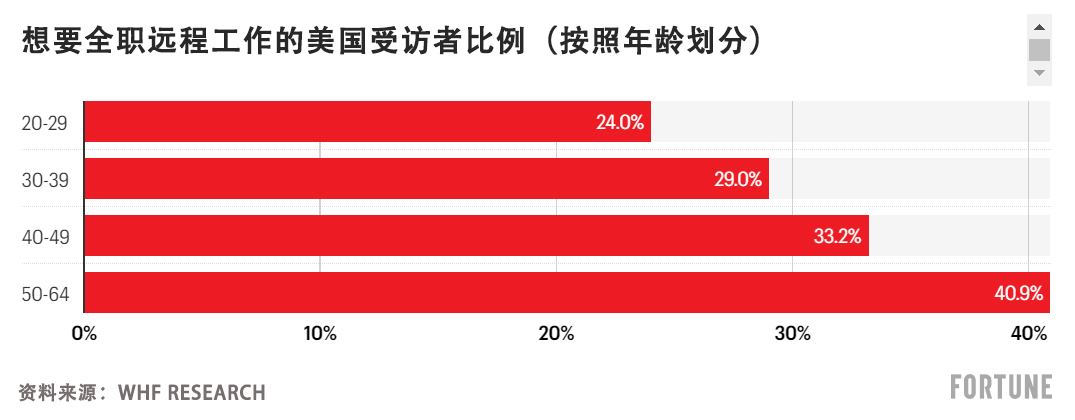
远程办公和重返办公室办公讨论的分歧似乎每周都在扩大。在这一点上,鸿沟如此之大,以至于许多叙事和谈话要点都在中间丢失了。
最近,人们的注意力转向了难以捉摸的远程工作者。公司领导认为员工居家办公的效率并不高——不管“生产力”在他们脑海中的真正含义是什么。微软公司(Microsoft)最近的一项调查发现,尽管绝大多数的老板质疑员工居家办公的工作量是否足够饱和,但实际上劳动生产率可能比新冠疫情前更高。
让经营公司的人相信这一点,确实很难。远程工作人员一直是公司关注的焦点,以至于老板们已经开始跟踪员工数据,例如敲键盘的次数,以衡量员工的工作效率。
微软公司的现代工作副总裁贾里德·斯帕塔罗在为《财富》杂志撰写的文章中写道:“我们把这种现象称为生产力偏执狂:领导者担心自己的员工工作量不饱和,而许多员工的工作量却比以往任何时候都多。”
因此,让我们暂时从这个1984年式的裂缝中爬出来,因为这一切都指向了一家公司似乎一直在兜售的说法:抵制重返办公室工作命令的员工只是想把办公室换成起居室、厨房桌子和第二卧室,在那里他们可以无聊地打发时光,安静辞职,然后敷衍了事。
但这种说法是错误的;即大多数人不想全职远程办公。老板们对他们在自己脑海中创造的趋势感到恐慌。
斯坦福大学(Stanford University)的教授尼克·布卢姆和WFH Research的数据显示,平均而言,只有31%的员工希望完全远程办公。对于年轻员工想永远居家办公的担忧是完全没有必要的。20岁至29岁的员工最不喜欢完全远程办公,只有24%的人更喜欢完全远程办公。布卢姆把这归因于他们对面对面指导和社交的需求。30岁至39岁的员工是下一梯队,29%的人更喜欢全职远程工作,而且随着员工年龄的增长,这一比例呈上升趋势。

对员工来说,灵活性是最重要的。自从新冠疫情爆发以来,重返工作岗位只是人们一闪而过的想法。正如布卢姆所说,他们更喜欢在适合自己的情况下,每周去办公室两到三次的自由。
我自己则倾向于周一和周五待在家里,然后让Outlook日历决定我周二、周三和周四在办公室的实际工作时间。我的情况就是大家的基本情况,因为如今,很多员工都是这样做的。
老板们似乎反对这样一种观点,即工作可能不会恢复到2019年的水平。很明显,我们需要重新思考未来的工作是什么样子的,以及实体办公室的作用——或者仅仅是开会的地方。
译者:中慧言-王芳
远程办公和重返办公室办公讨论的分歧似乎每周都在扩大。在这一点上,鸿沟如此之大,以至于许多叙事和谈话要点都在中间丢失了。
最近,人们的注意力转向了难以捉摸的远程工作者。公司领导认为员工居家办公的效率并不高——不管“生产力”在他们脑海中的真正含义是什么。微软公司(Microsoft)最近的一项调查发现,尽管绝大多数的老板质疑员工居家办公的工作量是否足够饱和,但实际上劳动生产率可能比新冠疫情前更高。
让经营公司的人相信这一点,确实很难。远程工作人员一直是公司关注的焦点,以至于老板们已经开始跟踪员工数据,例如敲键盘的次数,以衡量员工的工作效率。
微软公司的现代工作副总裁贾里德·斯帕塔罗在为《财富》杂志撰写的文章中写道:“我们把这种现象称为生产力偏执狂:领导者担心自己的员工工作量不饱和,而许多员工的工作量却比以往任何时候都多。”
因此,让我们暂时从这个1984年式的裂缝中爬出来,因为这一切都指向了一家公司似乎一直在兜售的说法:抵制重返办公室工作命令的员工只是想把办公室换成起居室、厨房桌子和第二卧室,在那里他们可以无聊地打发时光,安静辞职,然后敷衍了事。
但这种说法是错误的;即大多数人不想全职远程办公。老板们对他们在自己脑海中创造的趋势感到恐慌。
斯坦福大学(Stanford University)的教授尼克·布卢姆和WFH Research的数据显示,平均而言,只有31%的员工希望完全远程办公。对于年轻员工想永远居家办公的担忧是完全没有必要的。20岁至29岁的员工最不喜欢完全远程办公,只有24%的人更喜欢完全远程办公。布卢姆把这归因于他们对面对面指导和社交的需求。30岁至39岁的员工是下一梯队,29%的人更喜欢全职远程工作,而且随着员工年龄的增长,这一比例呈上升趋势。
对员工来说,灵活性是最重要的。自从新冠疫情爆发以来,重返工作岗位只是人们一闪而过的想法。正如布卢姆所说,他们更喜欢在适合自己的情况下,每周去办公室两到三次的自由。
我自己则倾向于周一和周五待在家里,然后让Outlook日历决定我周二、周三和周四在办公室的实际工作时间。我的情况就是大家的基本情况,因为如今,很多员工都是这样做的。
老板们似乎反对这样一种观点,即工作可能不会恢复到2019年的水平。很明显,我们需要重新思考未来的工作是什么样子的,以及实体办公室的作用——或者仅仅是开会的地方。
译者:中慧言-王芳
The fissure in remote work and return to office discourse seems to grow week-to-week. The chasm is so wide at this point that so many narratives and talking points are lost in the middle.
Lately, attention has turned to the elusive remote worker. Company leaders don’t think workers are productive enough when working from home—whatever “productivity” really means in their heads. A recent Microsoft survey found that despite a vast majority of bosses questioning whether workers were doing enough at home, productivity might actually be higher than it was pre-pandemic.
Good luck convincing the people running companies of that. Remote workers have remained in company crosshairs to the point that bosses have begun tracking employee data such as key strokes to measure of how productivity people are.
“We call this productivity paranoia: Leaders are worried their people aren’t working enough, while many employees are working more than ever,” Jared Spataro, Microsoft’s corporate vice president of modern work, wrote for Fortune.
So let’s attempt to crawl out of this 1984-esque fissure for a moment, because this is all pointing to a narrative companies seem to have been peddling: That workers pushing back against return-to-office mandates simply want to trade in offices for their living rooms, kitchen tables, and second bedrooms where they can twiddle their thumbs, quiet quit, and phone it in.
But that narrative is false; most people don’t want to work remotely full-time. Bosses are panicking over a trend they’re creating in their own heads.
On average, only 31% of workers are vying to be fully remote, according to data from Stanford professor Nick Bloom and WFH Research. And the fear around young employees wanting to work from home forever couldn’t be more misplaced. Workers age 20-29 are the least likely to prefer working fully remote, at 24%. Bloom attributes this to their need for in-person mentoring and socializing. Those age 30-39 are the next tier up, with 29% preferring fully-remote work, and it trends upward as workers’ age increases.
What has remained true is that flexibility is a top priority for workers. That's been the case since the idea of returning to work was a twinkle in the pandemic's eyes. As Bloom says, they prefer to have the freedom to go to offices two or three times a week when it suits them.
I myself tend to stay home Monday and Friday and then let my Outlook calendar dictate how much I'm physically in the office Tuesday, Wednesday, and Thursday. I'm pretty basic, because that's the case for a lot of workers today.
Bosses seem to be butting up against the idea that work likely won't return to what it looked like in 2019. What's clear is that we need to rethink in what the future of work looks like and what role the physical office—or simply meeting place—plays.






